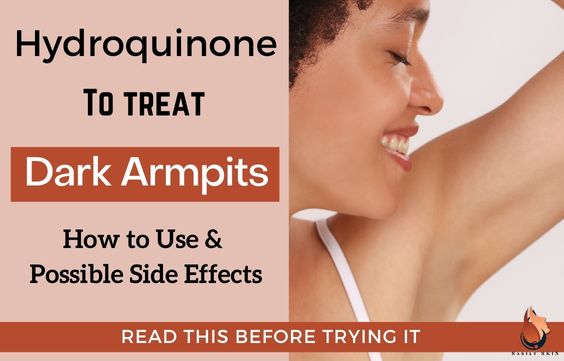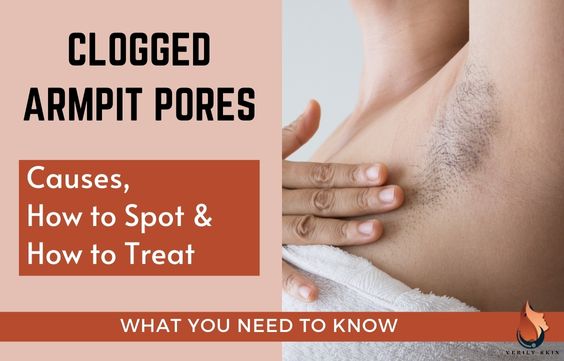Hydroquinone For Dark Underarms – How to Use & Side Effects

Hydroquinone is an active ingredient usually found in bleaching or whitening creams and is known to be super effective for removing dark spots.
And it has been shown to be able to work to lighten dark armpits. That’s why in this article we are going to cover:
- How well it will work,
- How to Use,
- The best brands,
- Correct Concentration,
- Side effects, and
- How long you can or will need to use it?
How Will Hydroquinone Lighten Dark Underarms
Hydroquinone once used correctly has proven to be very effective for treating dark underarms that can sometimes be very stubborn.
This is because Hydroquinone interrupts the production of melanin in the skin by inhibiting an enzyme called tyrosinase, which converts tyrosine to melanin in the production cycle.
By this mechanism of action, when used anywhere on the skin where pigment is being produced, that area will gradually become lighter. As old, pigmented cells are shed, they are replaced with less pigmented cells. Eventually, that area of skin will become lighter.
However, keep in mind that the results and how you need to use hydroquinone will vary based on how sensitive your underarms are and your skin type.
Side effects are possible and may also differ for individuals, keep reading to learn more.
Another great topical treatment for dark underarms is tretinoin. Click here to read about Tretinoin for Dark Underarms: How to Use Safely & Benefits.
For some great deodorants to help lighten dark underarms you can check out our articles:
Dove Even Tone Deodorant Review- Does It Work & Is It Safe
5 Best Deodorants to Lighten Dark Underarms- Prevent & Treat
How To Use Hydroquinone For Dark Underarms
Using your fingertips, apply a thin coating of hydroquinone to your underarms and evenly spread it out.
This is done 1-2 times per day for 3-6 months. Hydroquinone should be discontinued after 3 months if there are no significant results.
Keep in mind that the concentration you will need to use and how often you will need to apply the cream will vary for different people. How fast you will see results and your experience (with or without side effects) will also vary.
Also, ensure you moisturize when using Hydroquinone, click here to learn how to do so correctly.
Related Article – 5 Best Soaps to Lighten Dark Underarms, Necks & Thighs
Important Tip Before Using Hydroquinone
Also, it’s important to note that Hydroquinone is a more aggressive agent when compared to things like Vitamin C, Niacinamide, Azelaic Acid, etc. Therefore, I recommend that you see your doctor before starting this treatment on your skin.
Like all skin treatments, hydroquinone comes with possible risks and side effects as well. Your experience will also greatly depend on your skin type, the cause of your underarm darkness, how you use the cream, etc.
It is best to get professional advice and guidance to maximize your results while minimizing or avoiding possible side effects.
Some other very effective ways to treat dark underarms are:
DIY & Medical Ways to Quickly Whiten Underarms Permanently
Laser Whitening for Underarms: Cost, Risks, How Fast is it
Retinol For Dark Underarms: How to Use, Benefits & Effects
Video: Dermatologist Talks About Hydroquinone For Hyperpigmentation
How To Find Hydroquinone Products for Dark Armpits
Hydroquinone is not FDA-approved in the US for over-the-counter purchases. Therefore, many retail outlets will have removed products containing even low-strength hydroquinone. There may be one or two businesses that might still carry products containing hydroquinone.
However, I do not recommend that you use these products or attempt to buy them online. This will help to prevent problems with accurate concentrations, adverse effects, and general safety concerns.
Please be aware that Tri-Luma is the only hydroquinone-containing drug that the FDA has authorized as of 2022. This prescription medication is FDA-approved for the temporary relief of dark spots brought on by mild to moderate facial melasma. They recommend that you always use Tri-Luma with a qualified healthcare professional’s supervision.
Related Articles – Sunflower Oil For Underarms: Benefits & How To Use
What Concentration of Hydroquinone to Use for Underarms
I recommend that you start applying hydroquinone in a low concentration and then gradually work your way to higher concentrations. This will give your skin time to get used to the treatment and avoid excess irritation.
Tri-Luma cream is usually available in 0.01%, 0.05% and 4% concentrations.
Most people generally start with the lowest concentration, but even that needs to be used cautiously.
About 35% to 45% of hydroquinone is absorbed systemically after topical use so keep this in mind if you have super sensitive skin.
Depending on how your skin reacts, you may need to decrease or increase the concentration.
For better guidance and understanding, I recommend going through this process with your dermatologist.
Now for some natural remedies to dark armpits check out:
Turmeric for Dark Underarms – Benefits & Easy DIY Scrubs
Toothpaste For Dark Underarms – Ultimate DIY Guide
Using Rose Water to Lighten Dark Armpits & For Body Odor
How Often to Use Hydroquinone for Armpits
Most doctors recommend that you use hydroquinone at least once per day (at night).
However, based on how severe your underarm pigmentation is, and your skin’s reaction to the treatment, the frequency of application may vary.
I recommend starting gradually. Apply your hydroquinone at night, 2-3 times a week at first. Then, gradually increase the frequency until you can apply it every night. Observe your skin for any negative reactions.
Related Articles:
Niacinamide for Dark Underarms: How to Use for Best Results
How to Use Potatoes For Underarm Whitening
When You Can Expect Results Using Hydroquinone for Dark Armpits
Hydroquinone is known to be the most effective treatment for lightening dark underarms in 6-12 weeks.
However, it will work differently for different people. The results will depend on:
- How severe your skin darkness is
- The cause of your underarm darkness
- Your daily skincare routine
- The concentration of hydroquinone you are using
- How often you are using it
- The way your skin reacts to the treatment
Based on all the factors above, some people may see a visible difference in their underarm darkness in as little as 6 weeks, while others may need 2-3 months to see any difference.
Unfortunately, a small number of people report not seeing any results at all while others experience skin changes that make using hydroquinone unsustainable for them.
Related Article – Vitamin C For Underarms – Everything You Need To Know
How to use Hydroquinone in your Underarm Skincare Routine
While using hydroquinone, it is best to keep your underarm care routine as simple as possible.
- Do not use harsh soaps or cleansers under your arms. Use mild solutions.
- Avoid over-exfoliating. You do not need to stop exfoliating altogether but limit yourself to once per week.
- Moisturize your underarms well. Hydroquinone can cause excess dryness, especially if you already have dry skin. So, use a simple moisturizer to keep your underarms hydrated.
- Always use SPF. Even though your underarms are not usually exposed to the sun, when you are going out, still use some SPF. You never know when you may need to raise those arms!
- You can still use your deodorants and antiperspirants, but check them. Some deodorants and antiperspirants contribute to underarm darkness. Your underarms may also be more sensitive while using hydroquinone. So look out for reactions and if the darkness seems to persist, consider changing your deodorants.
- Avoid using peels, acids, retinol, or other intense skin care treatments while using hydroquinone unless directed by your doctor. Some people use hydroquinone and tretinoin together, but they are guided by their doctors and have been using them for years. If you are new to using hydroquinone, keep it simple and see how the treatment works before trying to mix and match.
Related Article – How Often to Exfoliate or Scrub Underarms for Best Results
Side Effects Of Using Hydroquinone For Dark Underarms
Generally, hydroquinone is well tolerated. However, when used on the underarms and other sensitive areas, there are a few possible side effects that you should be concerned about:
- Increased Dryness (especially if you already have dry skin)
- Itchiness
- Irritation
- Allergic or Irritant Contact Dermatitis
- Redness
- Inflammation (swelling, pain or tenderness, redness, & warmth in and around the area)
- Stinging
If you experience any of these side effects and they progress from mild to severe, wash your skin off with clean, room-temperature water and seek medical attention right away.
If your side effects are mild and bearable, please remember to inform your doctor as soon as you notice them so that they can advise you on whether you need to change or adjust your treatment to best benefit your skin.
Avoid using Hydroquinone when pregnant or breastfeeding – One dose of topical hydroquinone is absorbed systemically to a degree of 35 to 45%. Therefore, It is advised to limit exposure due to the significant absorption even though recent studies have not found an increased risk of abnormalities or harmful consequences in pregnant women.
Additionally, because it is yet unknown whether this medication is safe for nursing moms and their babies, breastfeeding women are encouraged to avoid using it.
Sources
1- Hydroquinone – StatPearls – NCBI Bookshelf
2- Hydroquinone: Uses, Safety, Side Effects, OTC Products, Alternatives
3- Hydroquinone – American Osteopathic College of Dermatology (AOCD)






